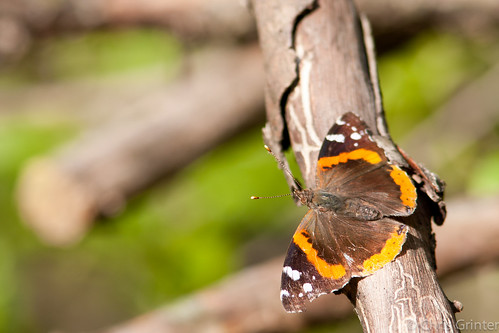Lokalna novica za večino vzhodnega ZDA in Kanadi je že aflutter (ima) pred kratkim s poročili o motenju Vanessa atalanta – Red admiral butterfly. Čeprav je to pogost pojav vsako pomlad za ti metulji na severno seliti iz svojih prezimovanja razlogov v južnem delu ZDA, čiste številke v tem letu so osupljive. Na naših dvoriščih je dobesedno na tisoče admiralov.
Kaj se torej razlikuje v tem letu?
O toplem spomladanskem vremenu se veliko ugiba (najtoplejši marec zabeležen za številne kraje) in pogosto veliko dezinformacij, ki so skupaj z neko entomologijo fotelja. Večina virov novic, na katere sem naletel, pravi, da je topla pomlad tem metuljem omogočila cvetenje in razmnoževanje v nenormalnem številu. Vendar to ni povsem mogoče, V. atalanta prezimuje kot odrasla oseba. Južne države nudijo tempam ravno dovolj toplo za odrasle Vanessa metuljčki, ki se jeseni skrijejo in bodo prvi, ki se bodo spomladi prebudili, da bi začeli pariti skok. Tudi če so bili metulji februarja budni, gostiteljske rastline še niso postale (ostrižniki); metulji na naših dvoriščih so iz lanskega leta.
Kaj pa, če bi vreme v tem razcvetnem ciklu igralo vlogo? Lansko leto je bilo z našo lepo in blago zimo leto La Niña. Leto prej je bil El Niño, večino vzhodne ZDA je napadla zima in trpeli smo v rokah epskega Chicaga “snežna kapsula”. Morda je ta kombinacija število prebivalcev dovolj upadla 2010/2011 ki je nato zmanjšal obremenitev parazitoidov, omogočajo večjo skupno plodnost metuljev poleti leta 2007 2011. Tisti prezimljivi metulji so bili nato deležni tople zime, ki bi lahko omogočila manjšo zimsko smrtnost. Medtem ko so se metulji pomladili na sever, ni bilo nobene mrazne noči, da bi se sekali na populacijo – samo veliko lačnih ptic. Rezultat bi bil nenavaden priliv migrirajočih metuljev.
Ampak potem spet…
Despite butterflies being so popular and well studied there doesn’t seem to be a perfect grip on what conditions each of the Vanessa species prefer. Spremenljivke gostiteljskih rastlin, obseg prebivalstva, vreme in parazitoidi igrajo pomembno vlogo pri številčnosti in razširjenosti. Did the weather cycles of the last few years variably effect one species over another? Kdo si želi doktorskega projekta (iz pekla)?
One of the best posts I’ve read is by Doug Taron over on Tanek Tapestry – he is skeptical of this warm weather theory. Critically this irruption is effecting only the population of the Red Admiral and any theory involving weather would also likely effect other migrant butterflies like the Vanessa virginiensis – the American Lady. He also points out that an abundant butterfly like the admiral has classic cyclical population booms and busts in sync with parasite populations. I recall another summer in the late 90’s of staggering Admiral populations. Parasites really do better explain what we see in our yards this spring. While the weather might not have caused the abundance of V. atalanta, there can be no denying that butterflies of all species have woken up much earlier this year.



As far as I recall, almost all temperate zone animals (and plants, Sumim) go thru boom and bust cycles. It’s pretty much the function/nature of the wildly variable environmental conditions of the ecosystems. Even the less common temperate zone species cycle but the effects are less noticed simply because of the lower population levels.
must have been a lovely sight, vanessa atlanta has been struggling in the UK for the past few years!!
A few years back you may have heard about the painted lady invasion in the UK very much the same as the USA i was counting well over 1000 an hour coming up the field from the english channel !
Quick question about la nina i believe the later part of 2010 was also la nina thats why the UK and northern USA had such cold weather